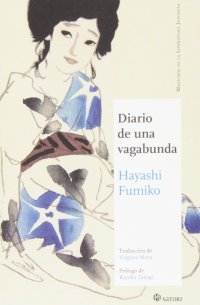
Review of the book “Diary of a Tramp” by Hayashi Fumiko
“Diary of a Tramp” (originally titled “Hōrōki” in Japanese) is an autobiographical novel written by Japanese author Hayashi Fumiko, first published in 1930. The work is a moving and sincere account of the author’s life during her years of youth, in which he experienced poverty, loneliness and the fight for survival in Japan during the Taisho era and the beginning of the Showa era.
The book “Diary of a Tramp” by Hayashi Fumiko is an autobiographical work that narrates the experiences of a young writer in Japan in the 1920s. The author, who was born into a poor and nomadic family, had to face the harsh reality of poverty, precarious work, heartbreak and social marginalization. Through her diary, she shows us her struggle to survive and to fulfill her dream of being a writer, as well as her most intimate and deep feelings.
The plot of “Diary of a Tramp” follows the protagonist, who is a transcript of Fumiko herself, as she travels through Japan in search of work and a place to call home. Throughout her journey, the protagonist encounters a series of colorful and memorable characters, each of whom influences her life in different ways. Through these interactions, Fumiko explores themes such as friendship, love, loss, and resilience in the midst of adversity.
Hayashi Fumiko is considered one of the most important writers of modern Japanese literature, and her work reflects her own life experience as an independent and rebellious woman who opposed the social conventions of her time. Her literary style is simple but poetic, and her stories are full of sensitivity, honesty, and realism.
“Diary of a Vagabond” is a book that brings us closer to the history and culture of Japan from a feminine and critical perspective, and that invites us to reflect on universal themes such as love, freedom, identity and the sense of life.
One of the highlights of “Diary of a Tramp” is Hayashi Fumiko’s ability to portray her life and experiences in a vivid and emotional way. Through a lyrical and evocative narrative style, the author presents her memories and reflections with an honesty and directness that allows the reader to empathize with her struggles and joys. Additionally, Fumiko uses her personal story as a means to explore broader themes, such as the status of women in Japanese society at the time, economic inequality, and the search for identity and purpose in an uncertain world.
Another notable aspect of the novel is the way Fumiko addresses the theme of wandering and freedom. Throughout the play, the protagonist is drawn to the idea of a nomadic and untethered life, in which she can explore the world and discover her true self. However, she also faces the difficulties and challenges that come with this way of life, such as economic insecurity and loneliness. This ambivalence is reflected in Fumiko’s narrative, which oscillates between celebration of freedom and nostalgia for stability and a sense of belonging.
In short, “Diary of a Tramp” is an exceptional work of literature that offers an intimate and moving insight into the life of Hayashi Fumiko during her younger years. With her lyrical and emotional storytelling style, and her explorations of universal themes such as friendship, love, and the search for identity, Fumiko manages to create a story that is both personal and deeply resonant. This novel is a must-read for those interested in Japanese literature, cultural history, and literary representations of nomadic life and resilience in the midst of adversity.
Source: https://algunoslibrosbuenos.com/diario-de-una-vagabunda


